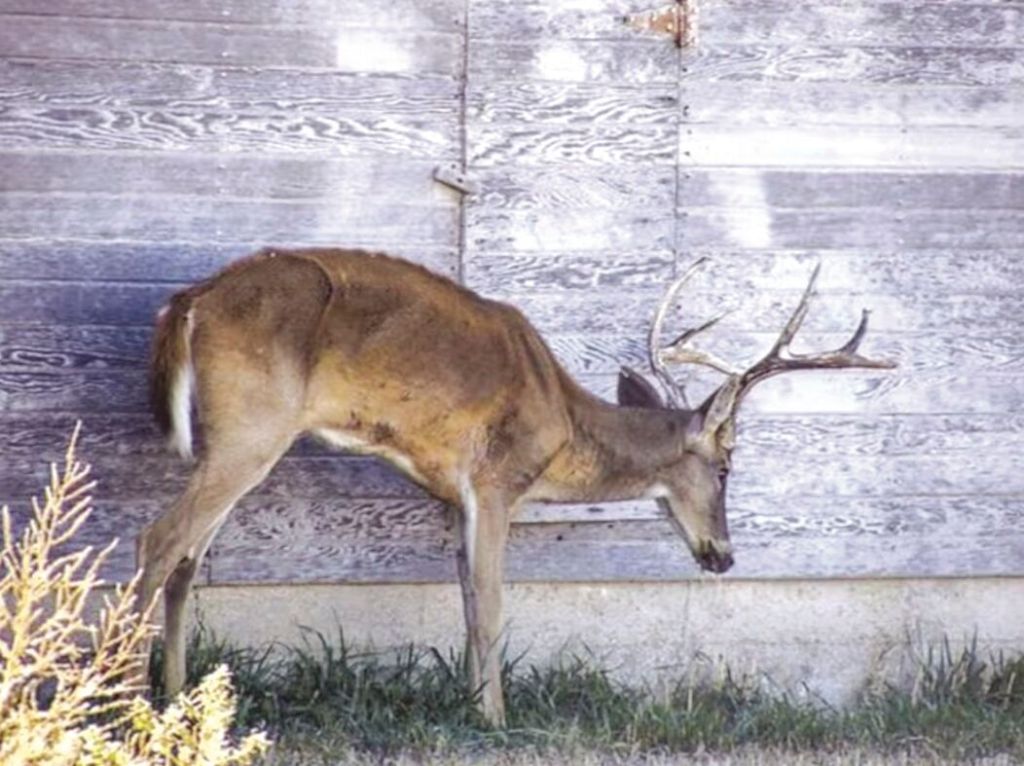Deer hunting world takes notice after possible link to CWD in human deaths
Published 12:00 am Wednesday, April 24, 2024

- A whitetail buck wracked with Chronic Wasting Disease stands near a wall at a Kansas Department of Wildlife and Fisheries research facility.
Following the release of a study about Chronic Wasting Disease, some hunters believe a possible link to the death of two hunters to CWD-infected deer meat was a matter of “when” not “if” while others decry a pattern of continued fear-mongering about the disease in deer.
One way or another, Field & Stream’s article posted online April 17 started shaking up the deer hunting world. The headline: “Study: Hunters Die After Consuming CWD-Infected Venison.”
Trending
Magazine writer Travis Hall, the magazine’s associate news editor, breaks down a study published earlier this month in the journal Neurology. As Hall points out in his story, the title of the study is enough to open the eyes of hunters and non-hunters alike: “Two Hunters from the Same Lodge Afflicted with Sporadic CJD. Is Chronic Wasting Disease to Blame?”
Based on the study, the much-discussed and dreaded transmission of CWD from hunter-harvested venison into humans for the first time ever recorded may have happened in 2022. The authors point out “a cluster of Creutzfeldt-Jakob disease cases after exposure to chronic wasting disease (CWD)-infected deer.”
They said those results are “suggestive of potential and prior transmission from CWD-infected deer to humans.”
Hall writes the recent study centers around an unidentified hunter who contracted CJD after regularly eating deer meat from deer infected with CWD. The 72-year-old hunter developed “rapid onset of confusion and aggression,” according to the study, and those are tell-tale symptoms of CJD.
The study reported: “Despite aggressive symptomatic treatment of seizures and agitation, the patient’s conditions deteriorated and he died within a month of initial presentation. The diagnosis was confirmed postmortem as sporadic CJD.”
Considering the victim had a history of consuming CWD-infected deer meat, authors suggested “a possible novel animal-to-human transmission of CWD” and also studied the case of one of the hunter’s friends who ate deer meat from the same deer population. The other man recently died of CJD, they noted.
Trending
How is it possible? Hall wrote CJD, better known for its association as the Mad Cow Disease, transmits in cows through mis-folded proteins called prions. Like CWD, it causes a cascade of brain-related maladies eventually leading to the death of cows that contract it. Also, Mad Cow Disease transmits to humans who eat infected beef and, when the disease shows in people, it’s referred to as Creutzfeldt-Jakob disease.
The April 9 study points out the cause for the recent CJD cases in hunters remains unproven, Hall wrote, then added the findings underscore the grave threats of consuming CWD-infected venison and the importance of testing deer meat for CWD by state game agencies when possible.
On April 18, Field & Stream’s hunting editor, Will Brantley, put the study and the magazine’s original story into perspective in his own story. Basically, Brantley wrote, if people read the fine print, the study merely concludes that a link can’t be ruled out and more study is necessary. In fact, in his last sentence, he wrote: “Meanwhile, I’ll take this new study with a large grain of salt – which I may well use on my next steaks of wild, clover-fed venison.”
Brantley took issue with some weak points in the study, particularly, “Clusters of sporadic CJD cases may occur in regions with CWD-confirmed deer populations, hinting at potential cross-species prion transmission. Surveillance and further research are essential to better understanding the possible association.”
Also, Brantley wrote, the study doesn’t pinpoint where this deer herd was or its CWD prevalence rate. According to the hunting editor, the study also really didn’t share whether the men ate infected venison. He wrote, “Maybe the researchers know beyond a shadow of a doubt they had their venison tested, that it came back positive, and they ate it anyway – but if they did, wouldn’t the study say so?”
And, he wrote, “Well, just because they can’t rule out CWD certainly doesn’t make CWD the culprit.”





